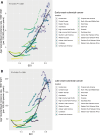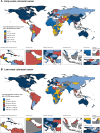Global burden, trends, and risk factors of early-onset and late-onset colorectal cancer from 1990 to 2021, with projections to 2040: a population-based study
- PMID: 40597636
- PMCID: PMC12211933
- DOI: 10.1186/s12876-025-04086-5
Global burden, trends, and risk factors of early-onset and late-onset colorectal cancer from 1990 to 2021, with projections to 2040: a population-based study
Abstract
Background: Early-onset colorectal cancer (EOCRC) and late-onset colorectal cancer (LOCRC) are significant public health concerns. There has been limited research comparing EOCRC and LOCRC, particularly regarding their global burden.
Methods: This study used data from the Global Burden of Disease (GBD) 2021 study, covering 204 countries and territories from 1990 to 2021. We analyzed incidence, prevalence, mortality, and disability-adjusted life years (DALY) for EOCRC and LOCRC. Age-standardized rates per 100,000 population were calculated, and trends were assessed using Joinpoint regression analysis. Decomposition analysis identified factors influencing DALY changes, with future burden projections through 2040.
Results: From 1990 to 2021, EOCRC cases nearly doubled, rising from 107,309 to 211,890, with the age-standardized incidence rate increasing from 4.58 to 5.15 per 100,000. LOCRC cases more than doubled, from 809,273 to 1,982,252, with the incidence rate rising from 79.67 to 84.38 per 100,000. Despite rising incidence, both EOCRC and LOCRC saw declines in mortality and DALY rates, reflecting improved treatment outcomes. In 2021, East Asia bore the highest burden of both EOCRC and LOCRC. The leading risk factors for both EOCRC and LOCRC were low intake of whole grains, low milk intake, and high red meat intake. Projections suggest incidence and prevalence of both cancers will continue rising through 2040, while mortality and DALY rates will decline, with LOCRC remaining predominant.
Conclusion: EOCRC incidence is rising rapidly, but LOCRC still accounts for the majority of cases globally. Targeted prevention, better screening, and efficient resource allocation are crucial to addressing this public health challenge.
Supplementary Information: The online version contains supplementary material available at 10.1186/s12876-025-04086-5.
Keywords: Cancer epidemiology; Disability-adjusted life years; Early-onset colorectal cancer (EOCRC); Global burden of disease; Late-onset colorectal cancer (LOCRC).
Conflict of interest statement
Declarations. Ethics approval and consent to participate: The Institutional Review Board Committee at the University of Washington granted approval for GBD 2021. This is a retrospective, observational cohort study; therefore, the requirement for informed consent was waived. Consent for publication: Not applicable. Competing interests: The authors declare no competing interests.
Figures






References
-
- Siegel RL, Miller KD, Fuchs HE, Jemal A. Cancer statistics, 2022. CA: Cancer J Clin. 2022;72(1):7–33. - PubMed
-
- Patel SG, Karlitz JJ, Yen T, Lieu CH, Boland CR. The rising tide of early-onset colorectal cancer: a comprehensive review of epidemiology, clinical features, biology, risk factors, prevention, and early detection. Lancet Gastroenterol Hepatol. 2022;7(3):262–74. - PubMed
-
- Lui RN, Tsoi KKF, Ho JMW, Lo CM, Chan FCH, Kyaw MH, et al. Global increasing incidence of Young-Onset colorectal Cancer across 5 continents: A joinpoint regression analysis of 1,922,167 cases. Cancer Epidemio Biomark Prev. 2019;28(8):1275–82. - PubMed
Grants and funding
- 2024QH2017/Startup Fund for scientific research, Fujian Medical University
- 2128300203/Construction Project of Fujian Province Minimally Invasive Medical Center
- 2128300203/Construction Project of Fujian Province Minimally Invasive Medical Center
- 2020Y9071/Joint Funds for the innovation of science and Technology
LinkOut - more resources
Full Text Sources

